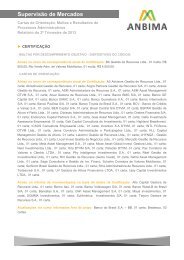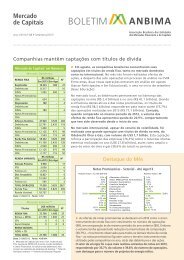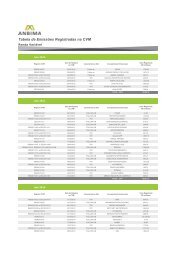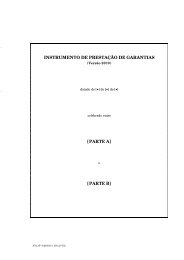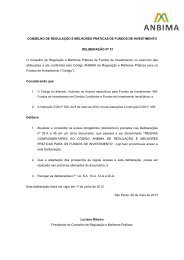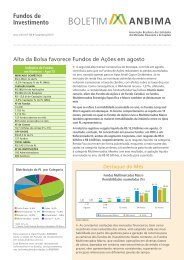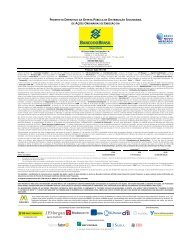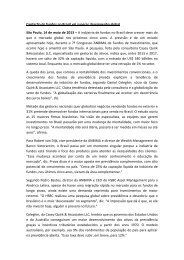The Brazilian Mutual Fund Industry - Anbima
The Brazilian Mutual Fund Industry - Anbima
The Brazilian Mutual Fund Industry - Anbima
Create successful ePaper yourself
Turn your PDF publications into a flip-book with our unique Google optimized e-Paper software.
Anuário 2012Anuário 2012indÚstria de fundos de investimentoindÚstria de fundos de investimentoEntre os investidores, o segmento Private liderou a captação,com o ingresso líquido de R$ 25 bilhões concentrado nascategorias Renda Fixa e Multimercados, categoria em queconcentra a maior parcela de seus recursos e na qual foi oprincipal investidor em 2011. Também merece destaque osingressos líquidos registrados pelas EAPC (Entidades Abertasde Previdência Complementar), com captação líquida de R$18,2 bilhões. O segmento Poder Público apresentou o terceiromaior resultado entre os investidores, com captação líquidade R$ 12,8 bilhões. O resultado contribuiu para ampliar suaparticipação na indústria, que passou de 6,4%, em 2010, para8,4%, em 2011.Vale observar que tanto os investidores Private como as EAPCvêm aumentando suas participações na indústria ao longodos últimos anos, ambos tendo acumulado, desde 2006,crescimento de 3,3 pontos percentuais. A participação doVarejo, por sua vez, caiu 11,5 p.p. no mesmo período, o que,considerando o crescimento econômico do país, sugerealguma migração desses investidores para os segmentosPrivate e EAPC, seja pelo crescimento da renda disponívelou pela maior conscientização em relação à importância dapoupança de longo prazo.of R$ 25 billion centered on the Fixed Income and Multi-marketcategories, categories in which the major part of their funds areconcentrated and in which it was the majority investor in 2011.<strong>The</strong> net income recorded by the EAPC (Entidades Abertas dePrevidência Complementar [Open Private Pension Entities]) withnet inflows of R$ 18.2 billion is also worth highlighting. <strong>The</strong> Stateposted the third best result among investors with a net cash inflowof R$ 12.8 billion. <strong>The</strong> result contributed to the expansion of itsparticipation in the industry - from 6.4% in 2010 to 7.4% in 2011.It is worth noting that, over the last few years, both Private investorsas well as the EAPC have been increasing their participation in theindustry, both recording accumulated growth of 3.3 percentagepoints since 2006. On the other hand, Retail’s participation fell11.5% over the same period which, considering the economicgrowth of the country, suggests some migration of these investorsto the Private and EAPC segments, either due to the growth ofdisposable income or greater awareness of the importance oflong-term saving.PerformanceO quadro econômico influiu diferenciadamente no retornodos ativos. No mercado de renda fixa, enquanto os títulosremunerados por índices de preços e taxas flutuantesse valorizaram diante da alta da inflação e dos juros noprimeiro semestre, aqueles relacionados às taxas prefixadasse valorizaram a partir da mudança na política monetáriaocorrida no final de agosto. Neste contexto, o tipo RendaFixa Índices, criado em dezembro de 2010, apresentou amaior rentabilidade da indústria no ano, com alta de 14,33%.Seu desempenho superou o do IMA-Geral, mas foi inferiorao do IRF-M e do IMA-B. Vale notar que a maior parte dessarentabilidade foi registrada a partir de agosto, quando avalorização desses índices foi mais significativa. Os fundos deRenda Fixa e Referenciado DI também apresentaram bomdesempenho, superando o IMA-S.Já o desempenhonegativo da Bolsapesou sobre arentabilidade dosfundos de ações.No entanto, asestratégias adotadaspor esses fundospermitiram mitigarperdas, fazendo comque os principaistipos da categoriasuperassem oIbovespa no ano.Neste sentido,merece destaque otipo Ações Dividendos, de cuja carteira devem constar somenteações de empresas com histórico consistente de pagamentode dividendos ou que apresentem essa perspectiva. Mesmodiante do recuo de 18,1% do Ibovespa, as ações integrantesdessas carteiras fizeram com que o tipo Ações Dividendosapresentasse retorno de 3,02%. O tipo Ações Livre, com quedade 6,87%, também conseguiu reduzir parcialmente as perdasregistradas pela Bolsa. A maior flexibilidade de gestão e apossibilidade de redução da exposição em renda variável, aoque tudo indica, contribuíram para esse resultado.Performance<strong>The</strong> economic picture affected returns on assets in different ways.In the fixed income market, in which securities remunerated byprice indexes and fluctuating rates increased in value in the faceof a rise in inflation and interest rates during the first half of theyear, those related to pre-fixed rates increased in value from thechange in monetary policy at the end of August. In this context,the Fixed Income type Indexes, set up in December 2010, showedthe highest yield in the industry during the year with an increase of14.33%. <strong>The</strong>ir performance surpassed that of the General MarketIndex (IMA-Geral), but was lower than the Fixed Income MarketIndex (IRF-M) and the ANBIMA Market Index (IMA-B). It is worthnoting that most of this yield was recorded from August when theincrease in these indexes was more significant. <strong>The</strong> Fixed Incomeand Interbank Deposit (DI) Referenced funds also performedwell, surpassing the ANBIMA Market Index - Overnight InterbankInterest Rate (SELIC) (IMA-S).Thus the negativeperformance of theStock Market weighedon the yield of thestock funds. However,the strategiesadopted by thesefunds enabled themto mitigate lossesso that the maintypes in the categorysurpassed the SãoPaulo Stock MarketIndex (Ibovespa) forthe year. In this regard,it is worth highlighting that the Dividend-bearing Stocks whoseportfolio can only include stocks of companies with a consistentrecord of dividend payments or that are adopting this approach.Even during the 18.1% retraction of the São Paulo Stock MarketIndex, the stocks making up these portfolios provided a return of3.02% on Dividend-bearing Stocks. <strong>The</strong> Free Action stocks that fell6.87%, also managed to partially reduce the losses recorded onthe Stock Market. All indications are that greater managementflexibility and the possibility of reducing exposure to variableincome contributed to this result.1011



